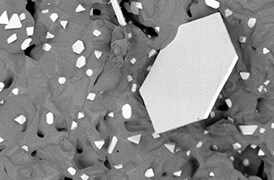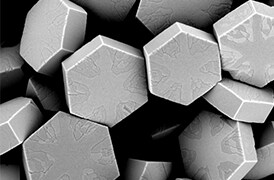Search Thermo Fisher Scientific

Materials Science
In situ Electron Microscopy
In situ microscopy for the high-resolution, real-time observation of samples’ responses to stimuli.
Join the conversation
In situ analysis
As materials research continues to advance, it is becoming increasingly important to not only observe materials in their initial and final state but also throughout their various applications. This might include imaging metal feedstocks as they are heated for additive manufacturing or wetting and drying of functionalized nanoparticles in order to understand their behavior in real-world conditions. Characterizing these behaviors is crucial as they impact critical research areas such as clean energy, transportation, catalysis, nano-electronics, and even human health.
In situ electron microscopy
While electron microscopy (EM) has traditionally been a static imaging method, advances in sample handling and rapid imaging have allowed the technique to be used for live, in situ observations. The high resolution of EM enables you to investigate nanoscale annealing behavior, phase transformations in metals, structural changes, sintering phenomena in catalysts, segregation/diffusion phenomena, and more.
In situ EM analysis of materials requires that the instruments offer fast and quantitative data acquisition along with dynamic high-resolution imaging. This is especially important when the investigated processes are dependent on rapidly changeable variables like temperature or humidity. For such dynamic experiments, the combination of flexibility in sample imaging, the ability to use different beam and vacuum conditions, and the fast collection of compositional data are indispensable.
In situ electron microscopes from Thermo Fisher Scientific
Thermo Scientific Environmental scanning electron microscopy (ESEM) and DualBeam (focused ion beam SEM) systems can operate under a variety of conditions that are needed for realistic in situ experiments. In particular, the MEMS-based Thermo Scientific μHeater Holder, in combination with in situ sample preparation, provides high-quality characterization at elevated temperatures.
Documents
Documents

Quality control and failure analysis
Quality control and assurance are essential in modern industry. We offer a range of EM and spectroscopy tools for multi-scale and multi-modal analysis of defects, allowing you to make reliable and informed decisions for process control and improvement.

Fundamental Materials Research
Novel materials are investigated at increasingly smaller scales for maximum control of their physical and chemical properties. Electron microscopy provides researchers with key insight into a wide variety of material characteristics at the micro- to nano-scale.

Battery Research
Battery development is enabled by multi-scale analysis with microCT, SEM and TEM, Raman spectroscopy, XPS, and digital 3D visualization and analysis. Learn how this approach provides the structural and chemical information needed to build better batteries.

Polymers Research
Polymer microstructure dictates the material’s bulk characteristics and performance. Electron microscopy enables comprehensive microscale analysis of polymer morphology and composition for R&D and quality control applications.

Metals Research
Effective production of metals requires precise control of inclusions and precipitates. Our automated tools can perform a variety of tasks critical for metal analysis including; nanoparticle counting, EDS chemical analysis and TEM sample preparation.

Catalysis Research
Catalysts are critical for a majority of modern industrial processes. Their efficiency depends on the microscopic composition and morphology of the catalytic particles; EM with EDS is ideally suited for studying these properties.

Nanoparticles
Materials have fundamentally different properties at the nanoscale than at the macroscale. To study them, S/TEM instrumentation can be combined with energy dispersive X-ray spectroscopy to obtain nanometer, or even sub-nanometer, resolution data.
Electron microscopy services for
the materials science
To ensure optimal system performance, we provide you access to a world-class network of field service experts, technical support, and certified spare parts.


















